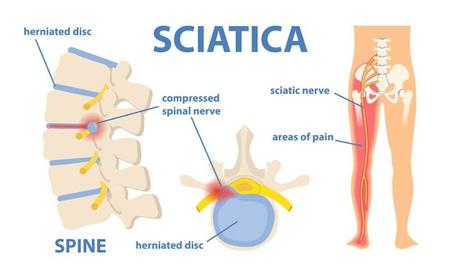
What is Sciatica?
The majority of people are familiar with
sciatica, which is low back pain that extends down the left or right buttock, into the leg, and occasionally all the way to the foot. The pain can be intense in some situations, and despite popular belief, sciatica usually goes away within three months with conservative treatment. Non-invasive therapies that can be done in the comfort of your own home are referred to as "conservative treatment."
The 5 at-home
sciatica therapies listed below are good possibilities for people who have recently started experiencing sciatic nerve pain or whose pain isn't severe, but I strongly advise you to get medical advice before attempting any of these at-home treatments. You should consult a doctor if you've had sciatica for a few weeks or have debilitating low back and leg pain.
At-Home Treatment for Sciatica Tip #1: Exercising Is Fine
While it may seem counterintuitive to exercise when you're in pain, studies show that resting too much can aggravate your back and leg discomfort. Instead, to relieve your sciatica, include light activity in your daily routine. Gentleness is the key: Painful or severe exercise should be avoided. A walk around the block is an excellent example of physical activity that maintains your spine strong while causing no more injury. Exercise causes the production of endorphins, which reduces your perception of pain in addition to strengthening your spine.
Tip #2 for Sciatica at Home: Stretch It Out
Gentle stretching should be a part of your everyday practice. Stretching is a great approach to increase spinal flexibility and range of motion while also strengthening your core and back. Furthermore, the majority of stretches are simple enough to do while watching the news or a movie.
At-Home Treatment for Sciatica Tip #3: Get the Ice Pack and the Heating Pad out of the freezer.
Sciatic nerve discomfort can be relieved quickly by alternating heat and cold therapy. Heat increases blood flow to the hurting location, while ice helps to relieve inflammation (which speeds healing). Sciatica is often accompanied by severe muscular spasms, which can be relieved with heat and cold. Apply an ice pack for 15 minutes every hour to the sore area, then heat for 15 minutes every 2 or 3 hours. Always use a barrier to protect your skin when using heat or ice therapy, and never sleep while doing so.
At-Home Treatment for Sciatica Refresh Your Posture (Tip #4)
If you stay in the same position for too long, whether you're working at your desk or relaxing at home, your sciatica pain may worsen. Changing positions every 20 minutes and maintaining appropriate posture can help reduce sciatica symptoms by easing the tension on the spine.
At-Home Treatment for Sciatica Tip #5: Make a trip to the pharmacy.
Nonsteroidal anti-inflammatory medicines (NSAIDs) sold over-the-counter (OTC) may help relieve
sciatica symptoms. NSAIDs, as opposed to acetaminophen (Tylenol), can be a suitable option because they treat both inflammation and discomfort. However, NSAIDs have health hazards that you should be aware of before using them, so talk to your doctor about them first. OTC NSAIDs include ibuprofen, aspirin, and naproxen.

